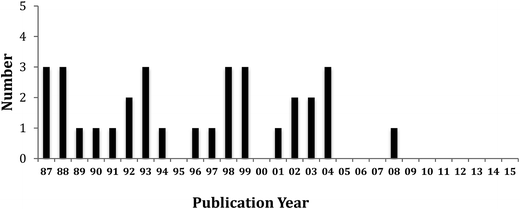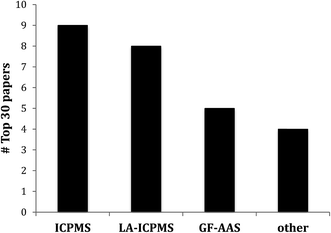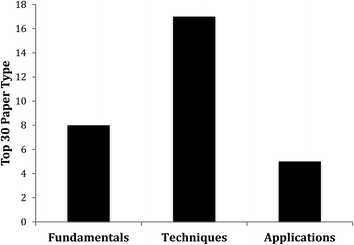JAAS – 30 years of manuscripts, citations, and scientific impact
This editorial, honoring the 30th year of JAAS publication, reprises one that the author wrote in 2006 in recognition of the 20th anniversary of the journal.1 In the 2006 editorial, we took a retrospective look at the journal through the lens of its top 20 publications, and we take the same approach here, looking at the journal's top 30 publications over the last 30 years (using manuscript citations as the measure – controversial as it may be). As before we also use citation data provided by the Web of Science (Thomson Reuters). The analysis is interesting in terms of both analytical trends and citation behavior.We again start with a look at some higher-level figures of interest for the journal (Table 1). There have now been 324 issues of the journal, with over 6000 research manuscripts that have resulted in nearly 135![[thin space (1/6-em)]](https://www.rsc.org/images/entities/char_2009.gif) 000 citations. The h-factor for the journal stands at 103, meaning there are 103 manuscripts with at least 103 citations each. The average number of citations/paper has jumped from 4.8 in 2006 to 21.8 in 2016, indicating that the journal is being read and cited more frequently. The citation number distribution provided in Table 1 also shows a notable increase in the number of papers with higher numbers of citations. All of these facts corroborate that the journal is being read often and is held in high esteem within the analytical science community.
000 citations. The h-factor for the journal stands at 103, meaning there are 103 manuscripts with at least 103 citations each. The average number of citations/paper has jumped from 4.8 in 2006 to 21.8 in 2016, indicating that the journal is being read and cited more frequently. The citation number distribution provided in Table 1 also shows a notable increase in the number of papers with higher numbers of citations. All of these facts corroborate that the journal is being read often and is held in high esteem within the analytical science community.
| Total JAAS issues | 324 (206) |
| Total JAAS manuscripts | 6189 (3724) |
| Total JAAS manuscript times cited | 134![[thin space (1/6-em)]](https://www.rsc.org/images/entities/char_2009.gif) 595 (17 595 (17![[thin space (1/6-em)]](https://www.rsc.org/images/entities/char_2009.gif) 791) 791) |
| Average citations per JAAS manuscript | 21.75 (4.78) |
| h-index for JAAS journal | 103 |
| Citation distribution | # publications |
|---|---|
| >200 citations | 15 (1) |
| 101–200 citations | 92 (30) |
| 51–100 citations | 491 (187) |
| 26–50 citations | 1212 (410) |
| 6–25 citations | 2848 (2071) |
| 1–5 citations | 946 (854) |
| 0 citations | 585 (171) |
The journal's top 30 publications are provided in rank order of citations in Table 2. As one might expect, a number of the 2006 Top 20 publications again appear in this list. In fact, 16 of the 2006 Top 20 publications reappear, including all of the first 13 publications from that listing. Those papers are shown in Table 1 with their 2006 ranking (parenthetically) alongside the current new ranking. Most of these older papers, again as one might expect, have fallen relatively in the new ranking. But several have risen, and in rather dramatic fashion. These include two landmark laser ablation papers (Longerich, Jackson, Günther; Rank 1 paper; and Günther et al., Rank 3 paper), and an isotope dilution ICPMS paper by Klaus Heumann et al. (Rank 6 paper). Other general trends are apparent, including a decrease in impact of graphite furnace AA papers, speciation papers, and ICPMS interference papers. Of the newer papers in the current Top 30 list, all except one are from the 1993–2004 publication years, indicating that it takes significant time and citation history (10–20 years!) to generate a significant number of citations to make the top 30 list. The lone paper published since the top 20 ranking made in 2006 is the 2008 Hu et al. paper (# 30 in this ranking) on the enhancement effect of adding nitrogen gas in the ICP for LA-ICPMS. That paper has resulted in 154 citations in only 7 years since publication. This mirrors what was observed in the 2006 ranking – that ranking only included highly cited papers up to 1998, and again shows that most highly cited papers take years to accumulate those citations. The distribution by year for the new Top 30 papers is given in Fig. 1, and interestingly indicates that in most years at least one top paper results each year over the 1986–2004 time period for the journal.
| Rank | Top 30 cited papers | Citations |
|---|---|---|
| a 2006 rank in Top 20 JAAS publications.1 b Paper titles in all caps are new (since 2006 listing) entries to top citation list. | ||
| 1 (6)a | Laser Ablation Inductively Coupled Plasma Mass Spectrometric Transient Signal Data Acquisition And Analyte Concentration Calculation. By: H. P. Longerich, S. E. Jackson and D. Günther, JAAS, 1996, 11, 899–904. | 658 |
| 2 | HF ISOTOPE RATIO ANALYSIS USING MULTI-COLLECTOR INDUCTIVELY COUPLED PLASMA MASS SPECTROMETRY: AN EVALUATION OF ISOBARIC INTERFERENCE CORRECTIONSb. By: N. C. Chu, R. N. Taylor, V. Chavagnac et al., JAAS, 2002, 17, 1567–1574. | 399 |
| 3 (13) | Capabilities Of An Argon Fluoride 193 Nm Excimer Laser For Laser Ablation Inductively Coupled Plasma Mass Spectrometry Microanalysis Of Geological Materials. By: D. Günther, R. Frischknecht, C. A. Heinrich et al., JAAS, 1997, 12, 939–944. | 295 |
| 4 (1) | Solid Sampling In Electrothermal Atomic-Absorption Spectrometry Using Commercial Atomizers – A Review. By: C. Bendicho and M. T. C. de Loos-Vollebregt, JAAS, 1991, 6, 353–374. | 285 |
| 5 (3) | Interferences In Inductively Coupled Plasma Mass-Spectrometry – A Review. By: E. H. Evans and J. J. Giglio, JAAS, 1993, 8, 1–18. | 283 |
| 6 (17) | Precision And Accuracy In Isotope Ratio Measurements By Plasma Source Mass Spectrometry. By: K. G. Heumann, S. M. Gallus, G. Radlinger et al., JAAS, 1998, 13, 1001–1008. | 239 |
| 7 | CARBON-ENHANCED INDUCTIVELY-COUPLED PLASMA-MASS SPECTROMETRIC DETECTION OF ARSENIC AND SELENIUM AND ITS APPLICATION TO ARSENIC SPECIATION. By: E. H. Larsen and S. Sturup, JAAS, 1994, 9, 1099–1105. | 235 |
| 8 | ENHANCED SENSITIVITY IN LASER ABLATION-ICP MASS SPECTROMETRY USING HELIUM-ARGON MIXTURES AS AEROSOL CARRIER. By: D. Günther and C. A. Heinrich, JAAS, 1999, 14, 9, 1363–1368. | 230 |
| 9 | EFFECT OF PARTICLE SIZE DISTRIBUTION ON ICP-INDUCED ELEMENTAL FRACTIONATION IN LASER ABLATION-INDUCTIVELY COUPLED PLASMA-MASS SPECTROMETRY By: M. Guillong and D. Günther, JAAS, 2002, 17, 831–837. | 228 |
| 10 (5) | Palladium Nitrate Magnesium-Nitrate Modifier For Electrothermal Atomic-Absorption Spectrometry: Performance For The Determination Of 21 Elements. By: B. Welz, G. Schlemmer and J. R. Mudakavi, JAAS, 1992, 7, 1257–1271. | 221 |
| 11 (2) | Matrix-Effect Observations In Inductively Coupled Plasma Mass–Spectrometry. By: S. H. Tan and G. Horlick, JAAS, 1987, 2, 745–763. | 220 |
| 12 (4) | Arsenic Speciation In Seafood Samples With Emphasis On Minor Constituents – An Investigation Using High-Performance Liquid-Chromatography With Detection By Inductively-Coupled Plasma-Mass Spectrometry. By: E. H. Larsen, G. Pritzl and S. H. Hansen, JAAS, 1993, 8, 1075–1084. | 212 |
| 13 | LASER ABLATION INDUCTIVELY COUPLED PLASMA MASS SPECTROMETRY: ACHIEVEMENTS, PROBLEMS, PROSPECTS. By: S. F. Durrant, JAAS, 1999, 14, 1385–1403. | 209 |
| 14 | DETERMINATION OF TOTAL AND SPECIATED ARSENIC IN RICE BY ION CHROMATOGRAPHY AND INDUCTIVELY COUPLED PLASMA MASS SPECTROMETRY. By: D. T. Heitkemper, N. P. Vela, K. R. Stewart et al., JAAS, 2001, 16, 299–306. | 203 |
| 15 (7) | Fully Automated Dissolution And Separation Methods For Inductively Coupled Plasma Atomic Emission-Spectrometry Rock Analysis - Application To The Determination Of Rare-Earth Elements. By: K. Govindaraju and G. Mevelle, JAAS, 1987, 2, 615–621. | 203 |
| 16 | METALLOMICS AS INTEGRATED BIOMETAL SCIENCE. By: H. Haraguchi, JAAS, 2004, 19, 5–14. | 196 |
| 17 | COMMON-PB CORRECTED IN SITU U-PB ACCESSORY MINERAL GEOCHRONOLOGY BY LA-MC-ICP-MS. By: M. S. A. Horstwood, G. L. Foster, R. R. Parrish et al., JAAS, 2003, 18, 837–846. | 196 |
| 18 | QUANTITATIVE ANALYSIS OF MAJOR, MINOR AND TRACE ELEMENTS IN FLUID INCLUSIONS USING LASER ABLATION INDUCTIVELY COUPLED PLASMA MASS SPECTROMETRY. By: D. Günther, A. Audetat, R. Frischknecht et al., JAAS, 1998, 13, 263–270. | 186 |
| 19 (8) | Palladium Nitrate – Magnesium-Nitrate Modifier For Graphite-Furnace Atomic-Absorption Spectrometry .2. Determination Of Arsenic, Cadmium, Copper, Manganese, Lead, Antimony, Selenium And Thallium In Water. By: B. Welz, G. Schlemmer and . R. Mudakavi, JAAS, 1988, 3, 695–701. | 174 |
| 20 | MAGNESIUM ISOTOPE HETEROGENEITY OF THE ISOTOPIC STANDARD SRM980 AND NEW REFERENCE MATERIALS FOR MAGNESIUM-ISOTOPE-RATIO MEASUREMENTS. By: A. Galy, O. Yoffe, P. E. Janney et al., JAAS, 2003, 18, 1352–1356. | 171 |
| 21 | COMPARING SEVERAL ATOMIC SPECTROMETRIC METHODS TO THE SUPER STARS: SPECIAL EMPHASIS ON LASER INDUCED BREAKDOWN SPECTROMETRY, LIBS, A FUTURE SUPER STAR. By: J. D. Winefordner, I. B. Gornushkin, T. Correll, et al., JAAS, 2004, 19, 1061–1083. | 164 |
| 22 | MULTIWALLED CARBON NANOTUBES AS SOLID-PHASE EXTRACTION ADSORBENT FOR THE PRECONCENTRATION OF TRACE METAL IONS AND THEIR DETERMINATION BY INDUCTIVELY COUPLED PLASMA ATOMIC EMISSION SPECTROMETRY. By: P. Liang, Y. Liu, L. Guo et al., JAAS, 2004, 19, 1489–1492. | 164 |
| 23 (9) | Flow-Injection Online Sorbent Extraction Preconcentration For Graphite-Furnace Atomic-Absorption Spectrometry. By: Z. Fang, M. Sperling and B. Welz, JAAS, 1990, 5, 639–646. | 163 |
| 24 (19) | Gas-Dynamics Of The Inductively Coupled Plasma Mass-Spectrometry Interface. By: D. J. Douglas and J. B. French, JAAS, 1988, 3, 743–747. | 161 |
| 25 (20) | Isotopic Ratio Measurement Using A Double Focusing Magnetic-Sector Mass Analyzer With An Inductively Coupled Plasma As An Ion-Source. By: A. J. Walder, P. A. Freedman, JAAS, 1992, 7, 571–575. | 159 |
| 26 | QUANTITATIVE ANALYSIS OF TRACE ELEMENT ABUNDANCES IN GLASSES AND MINERALS: A COMPARISON OF LASER ABLATION INDUCTIVELY COUPLED PLASMA MASS SPECTROMETRY, SOLUTION INDUCTIVELY COUPLED PLASMA MASS SPECTROMETRY, PROTON MICROPROBE AND ELECTRON MICROPROBE DATA. By: M. D. Norman, W. L. Griffin, N. J. Pearson et al. JAAS, 1998, 13, 477–482. | 158 |
| 27 (10) | Investigations Of A Reduced Palladium Chemical Modifier For Graphite-Furnace Atomic-Absorption Spectrometry. By: L. M. Vothbeach and D. E. Shrader, JAAS, 1987, 2, 45–50. | 158 |
| 28 | A CRITICAL ASSESSMENT OF LASER ABLATION ICP-MS AS AN ANALYTICAL TOOL FOR DEPTH ANALYSIS IN SILICA-BASED GLASS SAMPLES By: A. J. G. Mank and P. R. D. Mason, JAAS, 1999, 14, 1143–1153. | 156 |
| 29 | ISOTOPE RATIO MEASUREMENT OF LEAD, NEODYMIUM AND NEODYMIUM SAMARIUM MIXTURES, HAFNIUM AND HAFNIUM LUTETIUM MIXTURES WITH A DOUBLE FOCUSING MULTIPLE COLLECTOR INDUCTIVELY COUPLED PLASMA MASS-SPECTROMETER. By: A. J. Walder, I. Platzner and P. A. Freedman, JAAS, 1993, 8, 19–23. | 155 |
| 30 | SIGNAL ENHANCEMENT IN LASER ABLATION ICP-MS BY ADDITION OF NITROGEN IN THE CENTRAL CHANNEL GAS By: Z. Hu, S. Gao, Y. Liu, et al., JAAS, 2008, 23, 1093–1101. | 154 |
| 30 (12) | Determination Of Arsenic Species By High-Performance Liquid-Chromatography - Inductively Coupled Plasma Mass-Spectrometry. By: D. Beauchemin, K. W. M. Siu, J. W. McLaren et al., JAAS, 1989, 4, 285–289. | 154 |
| 30 (11) | Slurry Sample Preparation For Simultaneous Multi-Element Graphite-Furnace Atomic-Absorption Spectrometry. By: N. J. Miller-Ihli, JAAS, 1988, 3, 73–81. | 154 |
 | ||
| Fig. 1 Distribution by year for the Top 30 JAAS papers shown in Table 2. Note only a single paper past 2004 has received sufficient citations yet to qualify as a Top 30 Paper! | ||
Significant in this list of Top 30 papers is the contribution from the Detlef Günther group at ETH, Switzerland. That group has 5 papers in the Top 30, and 4 in the top 10 of this list! This is clearly a major contribution from a former Editorial Board member and Chair of this journal. The Bernard Welz group also had 3 papers in this list and Andrew Walder/Phil Freedman and E. H. Larsen also have 2 papers each in this list.
Review of these top papers by technique (Fig. 2) indicates that ICPMS remains the technique of choice, with 9 ICPMS papers and 8 LA-ICPMS papers respectively. Graphite furnace AA papers and miscellaneous other techniques follow behind in comparison. Compared to the 2006 distribution, laser ablation has clearly gained prominence over furnace techniques in the last decade. In terms of paper type (Fig. 3, subjective classification by the author), development and technique papers still predominate over both fundamental and application type papers. Speciation papers (classified separately as a paper type in the 2006 review) have declined markedly since the last summary, due in large part to the emergence of the RSC journal Metallomics in 2009, where those papers are now more likely to be published.
The Top 30 papers are newly available on the JAAS blog website (http://rsc.li/jaas-30) in recognition of its 30th anniversary. The journal has now been around long enough to span the careers of many analytical atomic spectrometrists (including the author). The foresight of the original founders, and their assessment of the need for the journal has certainly been validated. Thank you, readers and contributors to the journal, for your steadfast support and participation in making JAAS a top 10 analytical journal. Now, onwards to 40, and then 50 years of publication!
David W. Koppenaal
References
- D. W. Koppenaal, J. Anal. At. Spectrom., 2006, 21, 259–262 RSC.
| This journal is © The Royal Society of Chemistry 2016 |


